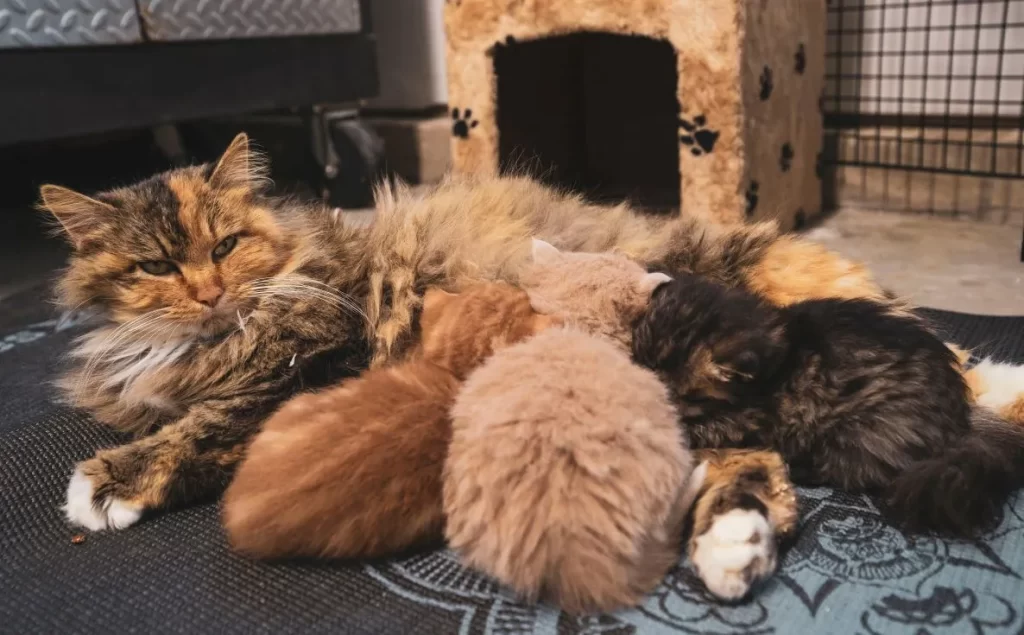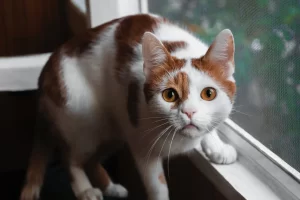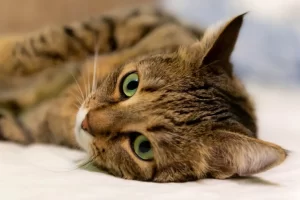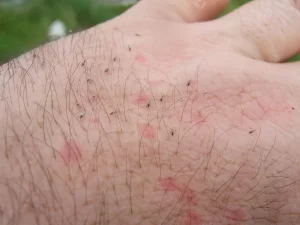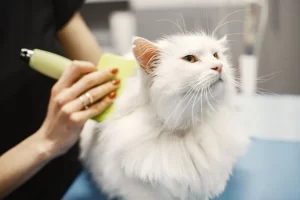Mastitis in cats is a painful and potentially serious condition that can cause discomfort and harm to your feline companion. Fortunately, there are several home treatments that can be used to help alleviate symptoms and promote healing. In this article, we will explore various mastitis in cats home treatments, including natural remedies, supplements, and over-the-counter medications, as well as provide information on when it is appropriate to use these treatments and when veterinary care should be sought. By understanding the available treatment options, cat owners can take an active role in their pet’s health and well-being.
If you prefer to listen on-the-go, be sure to check out the audio version of this blog below!
Table of Contents
ToggleMastitis in Cats: Signs and Symptoms
Mastitis is an inflammation of the mammary gland tissue that affects nursing cats. It occurs when bacteria enter the mammary gland through the teat, usually during nursing or grooming. While mastitis is more commonly seen in lactating cats, it can also occur in cats that are not nursing.
The signs and symptoms of mastitis in cats include swelling and redness of the mammary gland, heat and pain around the affected area, and sometimes fever. The affected gland may also feel lumpy or hard, and may leak pus or bloody discharge. In severe cases, the cat may stop nursing, become lethargic, lose her appetite, and develop a high fever.
It is important to note that mastitis can progress quickly, so it is important to seek veterinary care as soon as possible if you suspect your cat may have mastitis. Delaying treatment can lead to serious complications, such as sepsis, which can be life-threatening.
In addition to physical symptoms, cats with mastitis may also exhibit behavioral changes. For example, a normally docile cat may become more aggressive or defensive when the affected mammary gland is touched or handled. Cats may also experience discomfort when walking, jumping or climbing due to the pressure on the affected area.
It is important to monitor your cat’s behavior and health closely, especially during lactation. If you notice any changes in your cat’s behavior or physical symptoms, it is important to seek veterinary care promptly. Mastitis can be a serious condition and should not be ignored.
Causes of mastitis in cats
Mastitis in cats is most commonly caused by a bacterial infection that enters the mammary gland tissue through the teat. The bacteria can enter the teat from the environment, or through a break in the skin caused by scratching or other trauma.
Other causes of mastitis in cats may include:
- Poor hygiene: Poor hygiene can increase the risk of infection in the mammary gland. A dirty environment, soiled bedding or nursing equipment, and lack of proper cleaning can all contribute to the development of mastitis.
- Retained milk: If milk is not properly drained from the mammary gland, it can become trapped and lead to infection.
- Blocked ducts: Blocked ducts can prevent milk from flowing properly, leading to a buildup of milk in the gland and an increased risk of infection.
- Stress: Stress can weaken the immune system, making cats more susceptible to infection. Stressful events such as moving, introducing new cats to the household, or a change in routine can all contribute to the development of mastitis.
- Trauma: Trauma to the mammary gland, such as from rough handling or injury, can increase the risk of infection.
- Poor nutrition: Poor nutrition can weaken the immune system, making cats more susceptible to infection.
- Hormonal imbalances: Hormonal imbalances can disrupt the normal function of the mammary gland, leading to an increased risk of infection.
Diagnosis and Treatment of Mastitis in Cats
Diagnosing mastitis in cats typically involves a physical examination, evaluation of medical history, and laboratory tests. During the physical examination, the veterinarian will check the affected mammary gland for signs of swelling, redness, pain, and discharge. The veterinarian will also check the cat’s overall health, looking for signs of fever or other symptoms of illness. Read more on How often should I take my cat to the vet?
To confirm the diagnosis and identify the underlying cause of mastitis, the veterinarian may recommend laboratory tests, such as a bacterial culture and sensitivity test. This test involves taking a sample of the discharge from the affected gland and analyzing it for the presence of bacteria. The sensitivity test determines which antibiotics are most effective against the bacteria, helping the veterinarian to determine the best course of treatment.
The treatment of mastitis in cats typically involves antibiotics to eliminate the bacterial infection. The veterinarian will prescribe an appropriate antibiotic based on the results of the bacterial culture and sensitivity test. It is important to complete the full course of antibiotics as prescribed, even if the cat’s symptoms improve before the medication is finished.
In addition to antibiotics, the cat may require supportive care, such as pain medication or anti-inflammatory medication, to manage discomfort and reduce inflammation. The cat may also require supplemental feeding or fluids, especially if she is not nursing properly due to discomfort or illness.
In some cases, the veterinarian may recommend draining the affected gland to remove excess milk and relieve pressure. This is typically done under sedation to minimize discomfort and reduce the risk of injury.
Mastitis in cats: Home treatments and remedies
While it is possible to provide some supportive care at home for a cat with mastitis, it is important to note that antibiotics are typically necessary to eliminate the bacterial infection. Home remedies alone are unlikely to be sufficient for treating mastitis in cats, and delaying appropriate veterinary care can lead to serious complications.
That being said, there are some home remedies that can be used to provide supportive care for a cat with mastitis, under the guidance of a veterinarian. These may include:
- Warm or cold compresses: Applying warm or cold compresses to the affected gland can help to reduce inflammation and discomfort. Make sure to use a clean cloth or towel, and never apply a hot compress or heating pad to the cat’s skin. keep reading for more instructions on compresses and when to apply.
- Cool cabbage leaf compresses: Cabbage leaves contain enzymes that may help to reduce inflammation and swelling. To use this remedy, the leaves should be washed, dried, and chilled in the refrigerator for several hours. Once chilled, the leaves can be wrapped around the affected gland, making sure to cover the entire area. The leaves should be changed frequently to ensure they remain cool and fresh.
- Gentle massage: Gently massaging the affected gland can help to promote milk flow and reduce pressure. However, it is important to be gentle and avoid causing pain or injury.
- Good hygiene: Keeping the cat and her environment clean and free of bacteria can help to prevent the spread of infection. Make sure to clean the litter box regularly, provide clean bedding, and wash your hands before and after handling the cat.
- Probiotics: Probiotics may help to support the cat’s immune system and promote the growth of beneficial bacteria. However, it is important to discuss the use of probiotics with a veterinarian, as some products may be harmful or ineffective.
- Essential fatty acids: Essential fatty acids may help to reduce inflammation and promote healing. However, it is important to use a high-quality supplement that is specifically designed for cats, and to discuss the use of supplements with a veterinarian.
- Epsom salt soak: Soaking the affected gland in a solution of warm water and Epsom salt may help to reduce inflammation and promote healing. However, it is important to use a very dilute solution, as concentrated Epsom salt can be harmful to cats.
- Calendula oil: Calendula oil is a natural anti-inflammatory that may help to reduce swelling and promote healing. However, it is important to use a high-quality product that is specifically designed for cats, and to discuss the use of supplements with a veterinarian.
- Aloe vera gel: Aloe vera gel may help to soothe inflamed skin and promote healing. However, it is important to use a high-quality product that is specifically designed for cats, and to avoid using products that contain alcohol or other irritants.
- Gentle milk drainage: This can be done by placing gentle pressure on the gland with the fingertips, and allowing a small amount of milk to be released. However, it is important to avoid excessive milking, as this can lead to further irritation and may spread the infection. Additionally, it is important to practice good hygiene when handling the affected gland, as bacteria can be easily spread to other areas of the body.
Warm vs. Cold Compresses for Cat’s Mastitis: A Comprehensive Guide
Both warm and cold compresses can be helpful for providing relief from the symptoms of mastitis in cats, but they are used for different purposes and in different stages of the infection.
Warm compresses can be used in the early stages of mastitis, when the infection is still developing and the affected gland is swollen and painful. The warmth of the compress can help to increase blood flow to the affected area, which can help to promote healing and reduce inflammation. To use a warm compress, start by wetting a clean cloth with warm water. Wring out any excess water and apply the cloth to the affected gland for 10-15 minutes at a time, several times per day. Be sure to test the temperature of the compress on your own skin before applying it to your cat, to avoid burning or discomfort.
Cold compresses, on the other hand, are typically used in later stages of mastitis, when the infection is well established and the affected gland is red, hot, and painful. The coolness of the compress can help to reduce inflammation and provide relief from discomfort. To use a cold compress, start by wrapping a clean cloth around an ice pack or a bag of frozen peas. Apply the compress to the affected gland for 10-15 minutes at a time, several times per day. Be sure to wrap the compress in a cloth to avoid direct contact with your cat’s skin, which can cause discomfort or injury.
Essential Oils for Cat’s Mastitis: Safety and Effectiveness
While some essential oils may have antibacterial or anti-inflammatory properties that could potentially help to manage the symptoms of mastitis in cats, it is generally not recommended to use essential oils as a home remedy for this condition. Essential oils can be toxic to cats, and even small amounts of certain oils can cause serious health problems or even death.
If you are interested in using essential oils for your cat’s mastitis, it is important to first consult with a veterinarian who is knowledgeable about essential oil use in cats. They can provide guidance on which oils may be safe for use and how to properly dilute and administer them.
Some essential oils that may be considered safe for use in cats, when used in appropriate dilutions and under veterinary guidance, include chamomile, lavender, and tea tree oil. However, it is important to note that even these oils can be toxic in large doses or if not properly diluted. Additionally, some cats may have allergic reactions or other adverse effects to even small amounts of essential oils, so it is important to closely monitor your cat for any signs of discomfort or illness during and after essential oil use.
If you choose to use essential oils for your cat’s mastitis under veterinary guidance, be sure to follow all instructions carefully, including proper dilution, application method, and frequency of use. It is also important to avoid using essential oils near your cat’s eyes, nose, or mouth, and to keep essential oils and other potentially toxic substances out of your cat’s reach at all times.
Herbal Remedies for Cat’s Mastitis: Safe and Effective Options
Herbal remedies may offer some potential benefits for managing the symptoms of mastitis in cats, but it is important to note that not all herbs are safe for use in felines. Some herbs may be toxic to cats, while others may interact with medications or exacerbate existing health conditions. Therefore, it is recommended to first consult with a veterinarian who is knowledgeable about herbal medicine use in cats before using any herbal remedies for mastitis.
Some herbal remedies that may be considered safe for use in cats under veterinary guidance include:
- Calendula – Calendula has anti-inflammatory and antimicrobial properties that may help to soothe inflamed tissue and reduce the risk of infection. It can be applied topically as a salve or infused oil.
- Echinacea – Echinacea is a natural immune system booster that can help to fight off infection. It can be administered orally in tincture or capsule form.
- Goldenseal – Goldenseal is a potent antimicrobial herb that can help to fight off bacterial infections. It can be administered orally or applied topically as a salve.
- Marshmallow root – Marshmallow root has soothing and anti-inflammatory properties that may help to reduce swelling and inflammation in the mammary glands. It can be administered orally or applied topically as a poultice.
- Oregon grape – Oregon grape is a natural antimicrobial herb that can help to fight off infection. It can be administered orally in tincture or capsule form.
Before using any herbal remedies for your cat’s mastitis, it is important to discuss the potential risks and benefits with a veterinarian who is knowledgeable about herbal medicine use in cats. They can provide guidance on which herbs may be safe for use and how to properly prepare and administer them. Additionally, it is important to closely monitor your cat for any signs of discomfort or adverse reactions during and after herbal remedy use.
Supplements and Vitamins for Cat’s Mastitis Treatment: What You Need to Know
While it may be tempting to give your cat supplements or vitamins to help treat her mastitis at home, it is important to note that not all supplements are safe or effective for felines. Some supplements may interact with medications or exacerbate existing health conditions, while others may not offer any benefits for managing the symptoms of mastitis.
Before considering any supplements or vitamins for your cat’s mastitis treatment, it is recommended to first consult with a veterinarian who can assess your cat’s overall health and provide guidance on which supplements may be safe and effective for her specific needs.
Some supplements that may be considered safe and effective for managing mastitis symptoms in cats include:
- Probiotics – Probiotics are beneficial bacteria that can help to restore the natural balance of gut flora and boost the immune system. They may help to reduce the risk of infection and promote healing in the mammary glands.
- Vitamin C – Vitamin C is an antioxidant that can help to reduce inflammation and boost the immune system. It may be helpful for reducing swelling and promoting healing in the mammary glands.
- Vitamin E – Vitamin E is an antioxidant that can help to reduce inflammation and promote healing. It may be helpful for reducing swelling and improving skin health in the affected area.
- Omega-3 fatty acids – Omega-3 fatty acids are anti-inflammatory and can help to reduce inflammation and promote healing in the mammary glands. They may also help to support overall immune system function.
- Milk thistle – Milk thistle is an herb that can help to support liver function and promote detoxification. It may be helpful for reducing inflammation and supporting overall immune system function.
It is important to note that not all supplements or vitamins may be appropriate for all cats, and dosages may vary depending on the individual cat’s needs. Therefore, it is recommended to first consult with a veterinarian who can provide guidance on which supplements may be safe and effective for your cat’s specific needs and how to properly administer them.
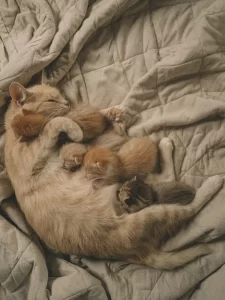
Risks and Potential Complications of Untreated Infection
If left untreated, mastitis in cats can potentially lead to a number of complications. These can include:
- Abscesses – Mastitis can cause the mammary gland to become inflamed and infected, which can result in the development of abscesses. These are pockets of pus that can form in the affected tissue, and can be painful and difficult to treat.
- Septicemia – Mastitis can lead to the spread of infection throughout the body, which can result in septicemia (blood poisoning). This is a serious and potentially life-threatening condition that requires immediate medical attention.
- Chronic mastitis – If mastitis is left untreated, it can become a chronic condition that is difficult to manage. This can result in ongoing inflammation and discomfort, and may require long-term treatment.
- Reduced milk production – Mastitis can affect the production of milk in the affected mammary gland, which can lead to reduced milk production and potential nutritional deficiencies in nursing kittens.
- Mammary tumors – In some cases, mastitis can lead to the development of mammary tumors, which can be cancerous and require aggressive treatment.
Is there any Over-the-counter medication?
There are no over-the-counter medications that are specifically formulated for the treatment of mastitis in cats. In fact, it is important to avoid giving your cat any medication without first consulting with a veterinarian, as many human medications can be toxic to cats.
That being said, there are some natural remedies that may be helpful in managing the symptoms of mastitis in cats. These include:
- Echinacea – Echinacea is a natural immune system booster that can help to fight off infections. It is available in capsule or liquid form, and can be added to your cat’s food or water.
- Goldenseal – Goldenseal is a natural antimicrobial herb that can help to fight off bacterial infections. It can be given to cats in capsule or liquid form, or as a tea.
- Vitamin C – Vitamin C is a natural antioxidant that can help to boost the immune system and promote healing. It can be given to cats in supplement form, or by feeding them foods that are high in vitamin C, such as oranges, strawberries, and broccoli.
- Manuka honey – Manuka honey has natural antibacterial properties and can help to soothe and heal inflamed tissues. It can be applied topically to the affected area or given to your cat orally.
Preventing Mastitis in Cats: Tips and Strategies for Cat Owners
While it may not be possible to completely prevent mastitis in cats, there are steps that can be taken to reduce the risk of your cat developing this condition. Some tips to help prevent mastitis in cats include:
- Regular grooming – Regular grooming can help to keep your cat’s skin and nipples clean and free from debris, which can help to prevent infections that can lead to mastitis.
- Proper nutrition – Providing your cat with a balanced and nutritious diet can help to support a healthy immune system, which can help to prevent infections that can lead to mastitis.
- Proper nursing – If you have a nursing cat, it is important to ensure that the kittens are nursing properly and not causing any damage to the nipples, which can lead to mastitis.
- Prompt treatment of any injuries or infections – If your cat sustains any injuries or develops any infections, it is important to seek veterinary care promptly in order to prevent the development of mastitis.
- Good hygiene practices – Practicing good hygiene, such as washing your hands before handling your cat and keeping their bedding clean, can help to prevent the spread of bacteria that can lead to mastitis.
How long does it take for mastitis in cats to heal?
The healing time for mastitis in cats can vary depending on the severity of the infection, the type of treatment used, and how quickly treatment is initiated. In general, mild cases of mastitis may resolve within a few days with proper treatment, while more severe cases may take several weeks to heal.
If treated promptly and appropriately, most cases of mastitis in cats can be successfully resolved. Treatment typically involves a combination of antibiotics, pain management, and supportive care, such as warm compresses or gland expression.
How common is mastitis in cats?
Mastitis in cats is relatively uncommon compared to other types of feline health issues. However, it can occur in cats of all ages and breeds, particularly in cats that are pregnant or nursing. Mastitis is more commonly seen in dogs, but it can still be a serious condition in cats if left untreated.
Factors that may increase a cat’s risk of developing mastitis include a weakened immune system, poor hygiene, and previous infections. Additionally, cats that are housed in overcrowded or unsanitary conditions may also be at a higher risk for developing mastitis.
Can mastitis in cats be passed on to humans?
Mastitis in cats is generally not considered to be a zoonotic disease, which means it is not typically transmitted from cats to humans. However, it is important to practice good hygiene when caring for a cat with mastitis to help prevent the spread of potential pathogens.
Cat owners should always wash their hands thoroughly before and after handling their cat, especially if the cat has mastitis or any other infectious condition. Wearing gloves when handling an infected cat or their bedding and avoiding contact with any discharge or secretions from the affected gland can also help reduce the risk of transmission.
Feeding Your Cat During Mastitis Recovery: A Guide to the Right Diet
A nutritious and well-balanced diet is important for cats recovering from mastitis. During recovery, cats may require additional nutrients and calories to help support their immune system and promote healing.
It is recommended to feed your cat a high-quality, balanced commercial cat food that is appropriate for their life stage and health needs. Look for foods that are rich in protein, vitamins, and minerals, and avoid feeding your cat table scraps or human food as this can disrupt their nutritional balance.
If your cat has a decreased appetite or difficulty eating, you may need to consider feeding them a special recovery diet or offering small, frequent meals throughout the day. Your veterinarian may also recommend adding supplements or vitamins to your cat’s diet to support their immune system and overall health during recovery.
The Cost of Veterinary Treatment for Mastitis in Cats
The cost of veterinary treatment for mastitis in cats can vary depending on the severity of the condition, the geographic location of the veterinary clinic, and the specific treatments required.
In general, the cost of a veterinary exam for mastitis can range from $50 to $200. Diagnostic tests, such as a bacterial culture or blood work, can add an additional $100 to $300 to the total cost. Medications, such as antibiotics or pain relievers, can range from $20 to $100 or more, depending on the type and duration of treatment.
Surgical intervention, such as a mastectomy, may be required in severe cases of mastitis and can cost anywhere from $500 to $2,000 or more. Additional costs may also be incurred for hospitalization, follow-up exams, and any necessary laboratory testing.

